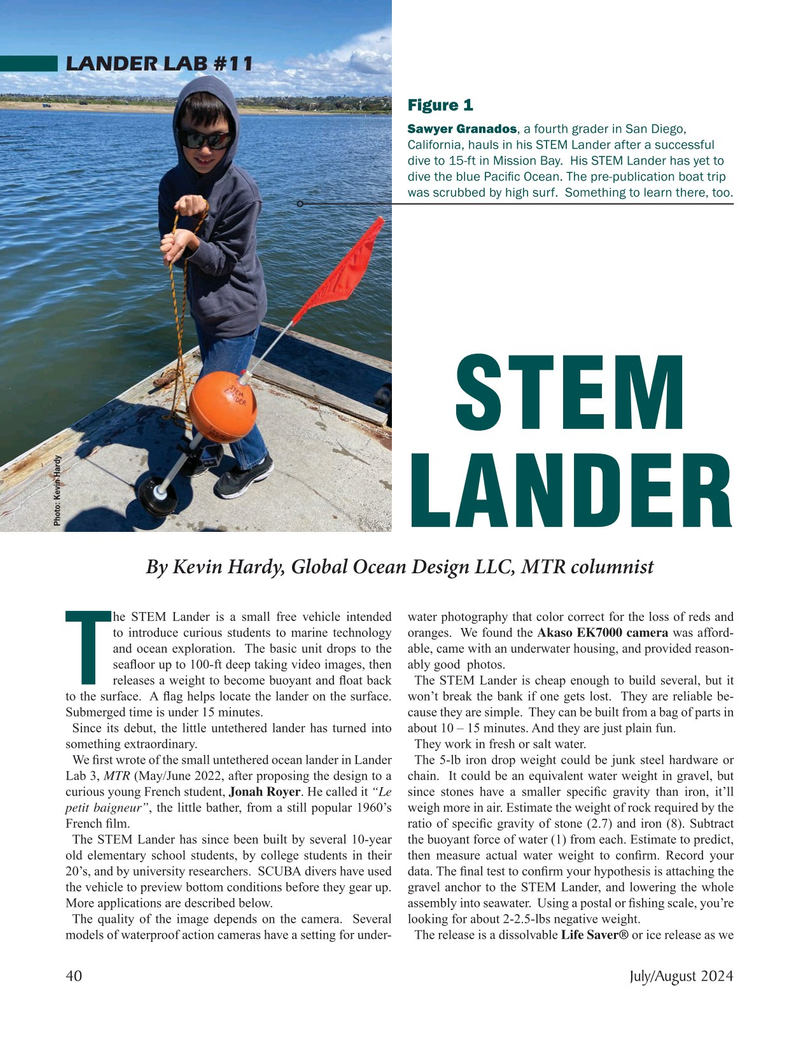
Page 40: of Marine Technology Magazine (July 2024)
Read this page in Pdf, Flash or Html5 edition of July 2024 Marine Technology Magazine
LANDER LAB #11
Figure 1
Sawyer Granados, a fourth grader in San Diego,
California, hauls in his STEM Lander after a successful dive to 15-ft in Mission Bay. His STEM Lander has yet to dive the blue Paci? c Ocean. The pre-publication boat trip was scrubbed by high surf. Something to learn there, too.
STEM
Photo: Kevin Hardy
LANDER
By Kevin Hardy, Global Ocean Design LLC, MTR columnist he STEM Lander is a small free vehicle intended water photography that color correct for the loss of reds and to introduce curious students to marine technology oranges. We found the Akaso EK7000 camera was afford- and ocean exploration. The basic unit drops to the able, came with an underwater housing, and provided reason- sea? oor up to 100-ft deep taking video images, then ably good photos.
Treleases a weight to become buoyant and ? oat back The STEM Lander is cheap enough to build several, but it to the surface. A ? ag helps locate the lander on the surface. won’t break the bank if one gets lost. They are reliable be-
Submerged time is under 15 minutes. cause they are simple. They can be built from a bag of parts in
Since its debut, the little untethered lander has turned into about 10 – 15 minutes. And they are just plain fun.
something extraordinary. They work in fresh or salt water.
We ? rst wrote of the small untethered ocean lander in Lander The 5-lb iron drop weight could be junk steel hardware or
Lab 3, MTR (May/June 2022, after proposing the design to a chain. It could be an equivalent water weight in gravel, but curious young French student, Jonah Royer. He called it “Le since stones have a smaller speci? c gravity than iron, it’ll petit baigneur”, the little bather, from a still popular 1960’s weigh more in air. Estimate the weight of rock required by the
French ? lm. ratio of speci? c gravity of stone (2.7) and iron (8). Subtract
The STEM Lander has since been built by several 10-year the buoyant force of water (1) from each. Estimate to predict, old elementary school students, by college students in their then measure actual water weight to con? rm. Record your 20’s, and by university researchers. SCUBA divers have used data. The ? nal test to con? rm your hypothesis is attaching the the vehicle to preview bottom conditions before they gear up. gravel anchor to the STEM Lander, and lowering the whole
More applications are described below. assembly into seawater. Using a postal or ? shing scale, you’re
The quality of the image depends on the camera. Several looking for about 2-2.5-lbs negative weight. models of waterproof action cameras have a setting for under- The release is a dissolvable Life Saver® or ice release as we 40 July/August 2024
MTR #5 (34-47).indd 40 7/25/2024 8:46:32 AM

 39
39

 41
41
